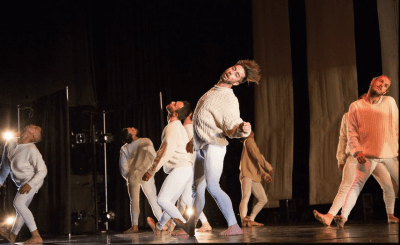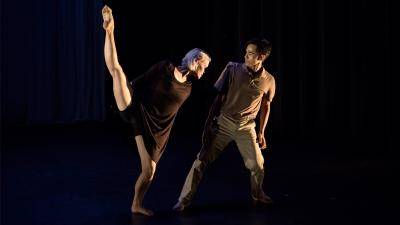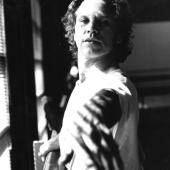Sometimes it matters where you see dance. With Erica Sobol’s new full-length dance odyssey runaway! by collidEdance at the Avalon Hollywood, concert dance has migrated from the tidy domain of the concert hall and black box performance space to a venue better known as ground zero for current music and the Hollywood club scene. On Tuesday the noisy rapport in the house placed runaway! somewhere between a standard piece of concert dance, and an active dialogue between performers and audience.
What is remarkable here is that Sobol and company are making something from scratch without the usual safety net of studied, familiar techniques.
Sobol, who directed, choreographed, and conceived runaway!, has built an evening length odyssey for her all-male cast of thirteen dancers. The program is divided into two acts, the first an episodic treatment of stand-alone ensembles and the second, leaning more on a narrative journey. Even without the glossing in the program notes on the titling of the program, it’s clear the context for these dancers makes of them a hopeful band of brothers. The two act production in fifteen sections lays out the emotional short comings and triumphs of going it alone and together.
The set (Samira Idroos) is a backdrop of several proscenium-filling white panels that become part of in-process action drip paintings. Both the paintings and the dancing evolve together. It was a good metaphor for Sobol’s choreography, which is complex and often unpredictable. Like the canvases, the dancers in Act I begin as a tabula rasa dressed in all-white union suits, eventually adopting street dress for some of the dancing in Act II. The piece makes a long arc, concluding where it began, with the men, their backs to the audience, looking up at the completed canvases and journeys they entail. The costumes were by Laura Flett. Lighting was by Francois-Pierre Couture. The evening was produced by Tarrah Lee Curtis and Kristina Sorensen and sponsored by Capezio A.C.E. Awards and Break the Floor Productions.

These are dancers working mostly in the world of commercial dance. The movement itself is highly gestural, idiosyncratic, and borrows from the edges of street and contemporary dance. Gone for the most part are the steely backbones, dagger legs and pointing feet. What is remarkable here is that Sobol and company are making something from scratch without the usual safety net of studied, familiar techniques. Still, her work is musical and picks up on subtle rhythmic impulses as well as the hits and cadences of the lyrics themselves.
Both acts have a thoughtful flow of large and smaller ensembles. Some dovetail together in continuous action. Others begin and end in blackouts. Keean Johnson was commanding in his Act I solo, “Love is All” with music by Kristian Matsson. That section was choreographed by company dancers Jason Gorman and Ryan Spencer. Gorman and Spencer also delivered an emotional duo with interlocking counterweighted movement for Ben Howard’s music for “Oats in the Water”. Act II’s large ensemble for “The Wolves” (music by Bon Iver) felt like the emotional heart of the evening. It was an exceptional piece of stand-alone choreography and highlighted Sobol’s skill in handling a complex ensemble. Teddy Tedholm’s personalized gestural mime (set to Jeff Buckley’s music) flowed over the edge of the stage and lent a leavening dose of dance comedy to his quirky Act II solo.
The evening opened with a well-paced, focused set by singer and songwriter Keaton Simons. With solid lyrics and complex, sometimes raw, guitar playing, his music and performing style set the tenor for much of the music that followed which explored the domain of intimate acoustic performances for solo voices. It was just one of the many thoughtful details in an evening of powerful dancing from this exceptional new company.
(The reviewed performance took place on Tuesday May 20, 2014 in Hollywood.)



